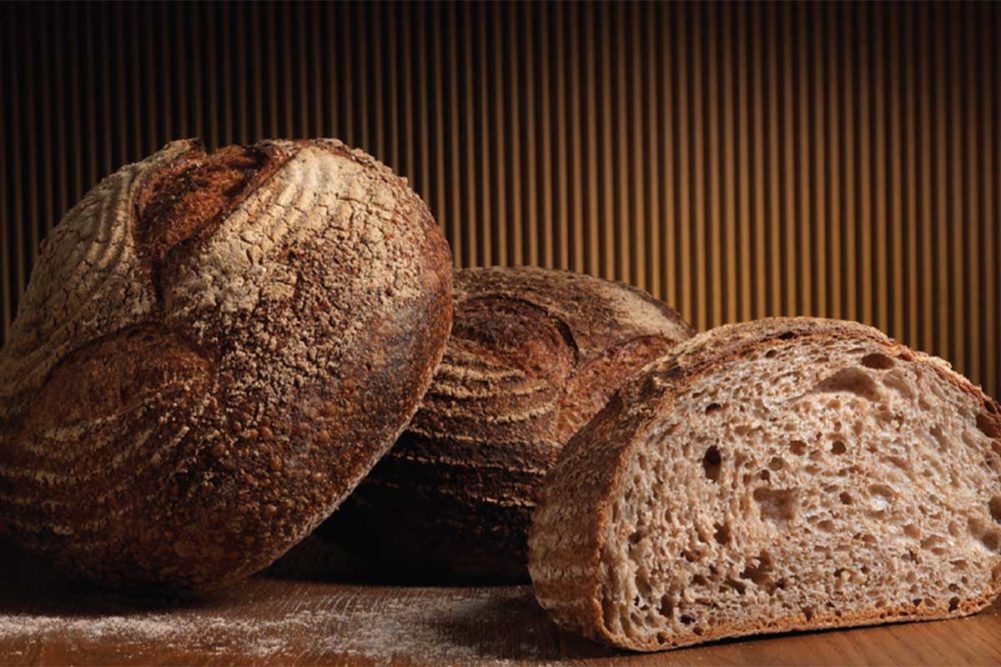Vital wheat gluten is a common ingredient industrial bakers rely on to move dough through the production process. It strengthens dough made with weaker flours so that it can withstand the forces equipment exert on it. This stand-by ingredient, however, succumbed early to supply chain pressures, becoming scarce and skyrocketing in price.
“All bakers are under the same constraints,” said Mark Zielonka, national R&D product manager, BreadPartners. “All bakers are now under an unspoken edict — adapt or die. We need to find ways to offer equal or better-quality ingredients at a better price.”
In response, some bakers are looking for ways around using vital wheat gluten to ensure their doughs can still make it through production with the same quality and consistency their customers expect. There are several strategies to making this happen. Bakers can switch to a higher quality flour: one with high-protein values and strength built in. Or bakers can turn to enzyme-based dough conditioners.
“Enzymatic-based dough conditioners can give clean label solutions that will give bread dough the strength and tolerance that gluten provides, which leads to great breads with good oven jump and crumb texture,” said Sean Hart, R&D manager, Puratos.
Standing in the gap
Bakers can use dough conditioners to reduce their reliance on added gluten in several ways. They can optimize the functionality of the gluten naturally present in the flour, or even in added gluten. Dough conditioners can also enhance the other components of wheat flour to make up the difference in functionality from lost gluten.
Optimizing the existing gluten in a formulation can unlock some of its functionality. Without water, gluten cannot fully activate. If a dough isn’t well-hydrated, bakers might add gluten where they don’t need it, or more than they should. By properly hydrating the dough, bakers can reduce the amount of gluten if not eliminate it completely. There are dough conditioning enzymes for this.
“Gluten must be completely hydrated to get the maximum effect while interestingly, the fibers in dough are not necessary to make bread,” explained Troy Boutte, PhD, vice president, innovation, AB Mauri North America. “If a dough isn’t well-hydrated, we add xylanases or cellulases to release water from the fiber to the gluten. By transferring water to the gluten, we can get a big improvement in gluten performance.”
Dough conditioning enzymes also work on other aspects of the wheat flour — starch, pentosans, proteins or lipids — to make up for lost gluten.
“One could also choose to add additional substrates to the dough to enzymatically modify or generate molecules with new functionalities,” said Luc Casavant, application director at Lallemand Baking.
Which enzyme, combination of enzymes or substrates will largely depend on what gluten functionality bakers are trying to replace. Gluten does a lot of heavy lifting in a formulation, but some applications may rely on gluten more for its extensibility rather than its elasticity.
“Gluten provides that stretch and pull back; that matters more in certain products,” explained Tess Brensing, senior product manager, functional systems, Corbion. “A tortilla, for instance, needs to be able to press out and not have sharp edges while still maintaining that chewiness. A bun or roll application, however, requires some additional strength because of the inclusion of a whole wheat flour or a lower flour quality.”
Knowing what the gluten specifically does is critical.
“To replace gluten functionality, bakers could choose a dough conditioner that provides additional volume, improves machineability and provides strength and tolerance for the production as well as enhance the rheological properties of the dough,” said Sherrill Cropper, PhD, new product development lab manager, bakery formulator, Lesaffre.
Yes, gluten contributes a lot of functionality to a formulation. Dough conditioners can do one of these, several or all of them.
“It depends on the product you are making and the outcomes you are looking to achieve,” said Matt Keyser, Northeastern sales, Brolite Products. “At Brolite, we will customize a dough conditioner to fit the baker’s need.”
When looking at enzymatic-based dough conditioners, bakers can expect them to have an oxidizing component — often ascorbic acid and certain enzymes — and a stabilizing component. These components work together to recreate the magic of vital wheat gluten.
“The oxidizing agents create more disulfide bridges from the flour during mixing for elasticity and volume while the stabilizing components help strengthen the dough matrix by creating a stronger gas/solid interface between gas bubbles and the dough matrix that are less likely to break as the dough expands and continues down the line,” said Ben Reusser, senior research development technologist, Cain Food Industries.
The most common enzymes found in these systems, said Anita Srivastava, PhD, CFS, senior technical service manager, bakery, Kemin Food Technologies, Americas, are glucose oxidase, xylanases and lipases. Each of these provide a different function. Glucose oxidase provides strengthening to the gluten structure while xylanases are used to improve hydration by breaking down the arabinoxylan matrix.
Phospholipases will help dough stability and maintain the cell structure of the finished product.
“By working with their ingredient manufacturers, customers can tailor the exact combination and amounts to achieve their desired results with respect to finished goods attributes, processing equipment and the processing environment,” Mr. Zielonka said. “Typically, employing a carefully selected dough conditioner provides all the strength and tolerance required for most applications.”
This article is an excerpt from the March 2022 issue of Baking & Snack. To read the entire feature on Dough Conditioners, click here.






